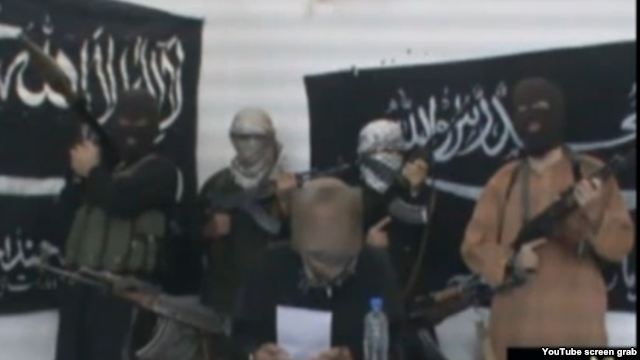
Terror Networks Link Kazakhstani Fighters in Afghanistan and North Caucasus to the Home Front
Publication: Eurasia Daily Monitor Volume: 9 Issue: 141
By:

On July 3, 2012, the leader of a Salafist group in Kostanay, northern Kazakhstan, was convicted of recruiting Kazakhstani citizens and providing them with fraudulent documents to help them travel to the Afghanistan-Pakistan region and join the insurgency (Interfax [Kostanay], July 3). While the Salafist group he led was responsible for helping fighters with the logistics of travel, other Salafist groups in Kazakhstan have been providing financial support to their compatriot fighters in Afghanistan. An investigation of 24 men arrested for plotting terrorist attacks in Atyrau, western Kazakhstan in September 2011, for instance, revealed that the men had been collecting and transferring money to Kazakhstani fighters in Pakistan through Kazakhstan’s BTA bank (Tengrinews, September 9, 2011).
These financial and logistics networks facilitate Kazakhstanis fighting in the Afghanistan-Pakistan border region with operatives back home. At least three times in 2011, the Az-Zahir Baibars Brigades of Jund al-Khilafah (Soldiers of the Caliphate), which was founded by three Kazakhs from Atyrau, ordered attacks in Kazakhstan from their base in the Afghan-Pakistani border region (Daily Times [Almaty], November 10, 2011). The first attack was on October 31, 2011, when one member of a five-person cell in Atyrau placed a homemade bomb in a dumpster near a local government building, while a second member blew himself up while placing a bomb in a dumpster near the Prosecutor General’s office. Some of the 47 residents of Atyrau who were convicted of terrorism in April 2012 for their alleged involvement with this five-person cell reportedly fought in Afghanistan before returning back home (Tengrinews, April 19; Interfax [Atyrau], July 6).
The Az-Zahir Baibars Brigades claimed responsibility for the Atyrau bombings on November 1, 2011, through Jund al-Khilafa’s media wing, Minbar Media, saying that the bombings were a “warning to the government,” that they “deliberately did not inflict deaths,” and that the second bomber was not in a “martyrdom-operation” but that the bomb blew up accidentally (Interfax [Almaty], November 1, 2011). Also through Minbar Media, the Brigades later claimed responsibility for Maksat Kariyev’s killing of five police officers in Taraz, southeastern Kazakhstan on November 12, 2011, and police shootings in Almaty carried out by a seven-person cell that was broken up by security forces on December 5, 2011, in Boraldai Village, outside of Almaty (ansar1.info, November 16, 2011).
There are an estimated 200 Kazakhstanis fighting in the Afghanistan-Pakistan border region with the Islamic Movement of Uzbekistan (IMU), Jund al-Khilafah and other militant movements, according to a report by the St. Petersburg-based Institute of Oriental Studies of the Russian Academy of Sciences (Tengrinews, October 30, 2011). The Islamic Jihad Union (IJU) also has Kazakhstani members as evidenced by a video that its media wing, Badr al-Tawhid, released in November 2011. It shows about 15 fighters in what appears to be Waziristan, Pakistan. Most of the fighters are identified in the subtitles as coming from Kazakhstan, while several other fighters are identified as coming from East Turkistan (Xinjiang, China), Turkey and Uzbekistan.
Another video released together with that footage showed six fighters, including a supposed “amir,” who speaks in Russian and says the fighters partake in military operations in Afghanistan, but that their “sphere of interest” is Central Asia, in particular Kazakhstan. A second fighter speaking in Russian says that after victory in Afghanistan, their “goal” is Central Asia. The fourth fighter, also speaking in Russian, talks about Muslim family members back in Kazakhstan and says many Kazakhs have died on the “path of jihad” in Waziristan and Afghanistan.
These two videos were called “Appeal of the Kazakh Mujahideen Taking Part in the Jihad to the Muslims of Kazakhstan” (“Obrashchenie Kazakskikh Mudzhakhidov Uchastvuyushikh v Dzhikhade k Muslumanam Kazakhstana”) and posted on the Caucasus Emirate’s main webpage Kavkazcenter.com (IIPER, No. 49, December 30, 2011). Notably, Kazakhstanis form the largest contingent of Central Asian fighters in the North Caucasus, although their numbers there are not as large as in Afghanistan. At least seven Kazakh fighters were killed and four arrested in Dagestan between 2009 and mid-2011. Two of the four arrested fighters admitted to having learned about the “war against Muslims” through Islamist militant websites and videos (RFE/RL [Caucasus Report], April 20, 2011).
Meanwhile, a review of Kazakh Islamic militants’ online activism shows that as early as November 2010, a Kazakhstani terrorist group called “Ansar Dine” (“Defenders of the Faith”) issued a call to Kazakhs to conduct hijra, or migration, to the Caucasus and Afghanistan, “establish links of material support,” and “assist the families of the mujahideen” (https://hunafa.com/?p=3839). This group, Jund al-Khilafah and others all appear to harbor the same goals and are using online media to recruit and propagandize.
Kazakh political analyst Rasul Zhumaly predicts that Kazakh fighters abroad all have the goal “to come back home [and] sooner or later connect with the extremist underground of Kazakhstan” (Tengrinews, September 27, 2011). In 2011, these calls were realized when the Az-Zahir Baibars Brigades in the Afghanistan-Pakistan border areas and the militants in Kazakhstan coordinated attacks. Zhumaly’s predication may be coming to fruition sooner than expected.




